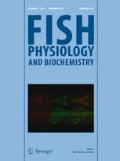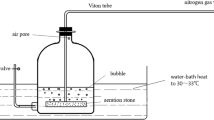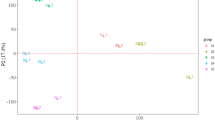Abstract
To understand the physiological response of estuarine fish to acidification, barramundi (Lates calcarifer) juveniles were exposed to acidified seawater in experimental conditions. The molecular response of barramundi to acidification stress was assessed by RNA-seq analysis. A total of 2188 genes were identified as differential expression genes. The gene ontology classification system and Kyoto Encyclopedia of Genes and Genomes database analysis showed that acidification caused differential expressions of genes and pathways in the gills of barramundi. Acidification had a great influence on the signal transduction pathway in cell process. Furthermore, we detected that numerous unigenes involved in the pathways associated with lipid metabolism, carbohydrate metabolism, amino acid metabolism, glycan biosynthesis and metabolism specific and non-specific immunity were changed. This study indicates that the physiological responses in barramundi especially the immune system and energy allocation correspond to the variation of environmental pH. This study reveals the necessity for assessment of the potential of estuarine fishes to cope with acidification of the environment and the need to develop strategies for fish conservation in coastal areas.






Similar content being viewed by others
References
Araújo JE, Madeira D, Vitorino R, Repolho T, Rosa R, Diniz M (2018) Negative synergistic impacts of ocean warming and acidification on the survival and proteome of the commercial sea bream, Sparus aurata. J Sea Res 139:50–61. https://doi.org/10.1016/j.seares.2018.06.011
Baumann H, Talmage S, Gobler C (2012) Reduced early life growth and survival in a fish in direct response to increased carbon dioxide. Nat Clim Chang 2:38–41. https://doi.org/10.1038/nclimate1291
Brennand H, Soars N, Dworjanyn S, Davis A, Byrne M (2010) Impact of ocean warming and ocean acidification on larval development and calcification in the sea urchin Tripneustes gratilla. PLoS One 5:e11372. https://doi.org/10.1371/journal.pone.0011372
Byrne M, Ho M, Wong E, Soars N, Selvakumaraswamy P, Shepard-Brennand H, Dworjanyn S, Davis A (2011) Unshelled abalone and corrupted urchins: development of marine calcifiers in a changing ocean. Proc R Soc B Biol Sci 278:2376–2383. https://doi.org/10.1098/rspb.2010.2404
Cai W, Hu X, Huang W, Murrell MC, Lehrter JC, Lohrenz SE, Chou W, Zhai W, Hollibaugh JT, Wang Y, Zhao P, Guo X, Gundersen K, Dai M, Gong G (2011) Acidification of subsurface coastal waters enhanced by eutrophication. Nat Geosci 4:766–770. https://doi.org/10.1038/ngeo1297
Chance RJ, Cameron GA, Fordyce M, Noguera P, Wang T, Collins C, Secombes CJ, Collet B (2018) Effects of repeated anaesthesia on gill and general health of Atlantic salmon, Salmo salar. J Fish Biol 93:1069–1081. https://doi.org/10.1111/jfb.13803
Che Z, Han Y, Zhao X, Shi W, Liu G, Chai X (1970) Ocean acidification increases cadmium accumulation in marine bivalves: a potential threat to seafood safety. Eur J Pharmacol 10:34–44. https://doi.org/10.1038/srep20197
Clements J, Hunt H (2014) Influence of sediment acidification and water flow on sediment acceptance and dispersal of juvenile softshell clams (Mya arenaria L.). J Exp Mar Biol Ecol 453:62–69. https://doi.org/10.1016/j.jembe.2014.01.002
Cui YB, Liu JK (1990) Comparison of energy budget among six teleosts - III. Growth rate and energy budget. Comp Biochem Physiol A Physiol 97:381–384. https://doi.org/10.1016/0300-9629(90)90627-5
Dacks JB, Field MC (2018) Evolutionary origins and specialisation of membrane transport. Curr Opin Cell Biol 53:70–76. https://doi.org/10.1016/j.ceb.2018.06.001
de Weys J, Santos IR, Eyre BD (2011) Linking groundwater discharge to severe estuarine acidification during a flood in a modified wetland. Environ Sci Technol 45:3310–3316. https://doi.org/10.1021/es104071r
Dineshram R, Quan Q, Sharma R, Chandramouli K, Yalamanchili HK, Chu I, Thiyagarajan V (2015) Comparative and quantitative proteomics reveal the adaptive strategies of oyster larvae to ocean acidification. Proteomics 15:4120–4134. https://doi.org/10.1002/pmic.201500198
Duarte C, Hendriks I, Moore T, Olsen Y, Steckbauer A, Ramajo L, Carstensen J, Trotter J, Mcculloch M (2013) Is ocean acidification an open-ocean syndrome? Understanding anthropogenic impacts on seawater pH. Estuar Coasts 36:221–236. https://doi.org/10.1007/s12237-013-9594-3
Dupont S, Dorey N, Stumpp M, Melzner F, Thorndyke M (2013) Long-term and trans-life-cycle effects of exposure to ocean acidification in the green sea urchin Strongylocentrotus droebachiensis. Mar Biol 160:1835–1843. https://doi.org/10.1007/s00227-012-1921-x
Edwards SL, Marshall WS (2013) Principles and patterns of osmoregulation and euryhalinity in fishes. In: McCormick SD, Brauner CJ, Farrell AP (eds) Fish physiology. Academic Press, Amsterdam. https://doi.org/10.1016/B978-0-12-396951-4.00001-3
Fabry V, Seibel B, Feely R, Orr J (2013) Impacts of ocean acidification on marine fauna and ecosystem processes. Trends Ecol Evol 28:178–186. https://doi.org/10.1093/icesjms/fsn048
Gillanders B, Elsdon T, Halliday I, Jenkins G, Robins J, Valesini F (2011) Potential effects of climate change on Australian estuaries and fish utilising estuaries: a review. Mar Freshw Res 62:1115–1131. https://doi.org/10.1071/MF11047
Halpern BS, Walbridge S, Selkoe KA, Kappel CV, Micheli F, D'Agrosa C, Bruno JF, Casey KS, Ebert C, Fox HE, Fujita R (2008) A global map of human impact on marine ecosystems. Science 319:948–952. https://doi.org/10.1126/science.1149345
Hofmann G, Smith J, Johnson K, Send U, Levin L, Paytan A, Price N, Peterson B, Takeshita Y, Matson P, Crook E, Kroeker K, Gambi M, Rivest E, Frieder C, Yu P, Martz T (2011) High-frequency dynamics of ocean pH: a multi-ecosystem comparison. PLoS One 6:e28983. https://doi.org/10.1371/journal.pone.0028983
Hong J, Chen X, Liu S, Fu Z, Han M, Wang Y, Gu Z, Ma Z (2019) Impact of fish density on water quality and physiological response of golden pompano (Trachinotus ovatus) flingerlings during transportation. Aquaculture 507:260–265. https://doi.org/10.1016/j.aquaculture.2019.04.040
Hu X, Cai W (2013) Estuarine acidification and minimum buffer zone—a conceptual study. Geophys Res Lett 40:5176–5181. https://doi.org/10.1002/grl.51000
Ianson D, Allen SE, Moore-Maley BL, Johannessen SC, Macdonald ARW (2016) Vulnerability of a semienclosed estuarine sea to ocean acidification in contrast with hypoxia. Geophys Res Lett 43:5793–5801. https://doi.org/10.1002/2016GL068996
Jacob RA (1995) The integrated antioxidant system. Nutr Res 15:755–766. https://doi.org/10.1016/0271-5317(95)00041-G
Johansen K, Pettersson K (1981) Gill O2 consumption in a teleost fish, Gadus morhua. Respir Physiol 44:277–284. https://doi.org/10.1016/0034-5687(81)90023-2
Juliano RL, Haskill S (1993) Signal transduction from the extracellular matrix. J Cell Biol 120:577–585. https://doi.org/10.1083/jcb.120.3.577
Kaiser CA, Krieger M, Lodish H, Berk A (2007) Molecular cell biology. WH Freeman http://115.78.239.30:8080/dspace/handle/DNULIB_52011/2575
Kaniewska P, Campbell PR, Kline DI, Rodriguez-Lanetty M, Miller DJ, Dove S, Hoegh-Guldberg O (2012) Major cellular and physiological impacts of ocean acidification on a reef building coral. PLoS One 7:e34659. https://doi.org/10.1371/journal.pone.0034659
Kishimoto T, Taga T, Akira S (1994) Cytokine signal transduction. Cell 76:253–262. https://doi.org/10.1016/0092-8674(94)90333-6
Kordon AO, Karsi A, Pinchuk L (2018) Innate immune responses in fish: antigen presenting cells and professional phagocytes. Turk J Fish Aquat Sc 18:1123–1139. https://doi.org/10.4194/1303-2712-v18_9_11
Kroeker KJ, Kordas RL, Crim RN, Singh GG (2010) Meta-analysis reveals negative yet variable effects of ocean acidification on marine organisms. Ecol Lett 13:1419–1434. https://doi.org/10.1111/j.1461-0248.2010.01518.x
Kulbacka J, Choromańska A, Rossowska J, Weżgowiec J, Saczko J, Rols M (2017) Cell membrane transport mechanisms: ion channels and electrical properties of cell membranes. In: Kulbacka J, Satkauskas S (eds) Transport across natural and modified biological membranes and its implications in physiology and therapy. Springer International Publishing, Cham, pp 39–58. https://doi.org/10.1007/978-3-319-56895-9_3
Li B, Dewey C (2011) RSEM: accurate transcript quantification from RNA-Seq data with or without a reference genome. BMC Bioinforma 12:323. https://doi.org/10.1186/1471-2105-12-323
Lin C, Melville MD, White I, Wilson BP (1995) Human and natural controls on the accumulation, acidification and drainage of pyritic sediments: Pearl River Delta, China and Coastal New South Wales. Aust Geogr Stud 33:77–88. https://doi.org/10.1111/j.1467-8470.1995.tb00686.x
Liu YJ, Hu J, Zhou SJ, Yang R, Qin JG, Ma ZH, Yang QB (2018) Effect of acute ammonia stress on antioxidant enzymes and digestive enzymes in barramundi Lates calcarifer larvae. J Aquac Bamidgeh 15:1–11 http://hdl.handle.net/10524/58322
Mallatt J (1985) Fish gill structural changes induced by toxicants and other irritants: a statistical review. Can J Fish Aquat Sci 42:630–648. https://doi.org/10.1139/f85-083
Martin LB, Scheuerlein A, Wikelski M (2003) Immune activity elevates energy expenditure of house sparrows: a link between direct and indirect costs? Proc Royal Soc B Biol Sci 270:153–158. https://doi.org/10.1098/rspb.2002.2185
McCormick SD, Regish AM, Christensen AK, Björnsson BT (2013) Differential regulation of sodium-potassium pump isoforms during smolt development and seawater exposure of Atlantic salmon. J Exp Biol 216:1142–1154. https://doi.org/10.1242/jeb.080440
McKim JM, Erickson RJ (1991) Environmental impacts on the physiological mechanisms controlling xenobiotic transfer across fish gills. Physiol Zool 64:39–67. https://doi.org/10.1086/physzool.64.1.30158513
Melzner F, Gutowska MA, Langenbuch M, Dupont S, Lucassen M, Thorndyke MC, Bleich M, Pörtner HO (2009) Physiological basis for high CO2 tolerance in marine ectothermic animals: pre-adaptation through lifestyle and ontogeny? Biogeosciences 6:2313–2331. https://doi.org/10.5194/bg-6-2313-2009
Miller N, Clem L (1984) Temperature-mediated processes in teleost immunity: differential effects of temperature on catfish in vitro antibody responses to thymus-dependent and thymus-independent antigens. J Immunol 133:2356–2359. https://doi.org/10.1016/0145-305X(84)90038-7
Mommsen TP (1984) Metabolism of the fish gill. In: Hoar WS, Randall DJ (eds) Fish Physiology. Academic Press, pp 203–238
Moore R (1982) Spawning and early life history of burramundi, Lates calcarife (Bloch), in Papua New Guinea. Mar Freshw Res 33:647–661. https://doi.org/10.1071/MF9820647
Morgan AJ, Galione A (2007) Fertilization and nicotinic acid adenine dinucleotide phosphate induce pH Changes in acidic Ca2+ stores in Sea Urchin Eggs. J Biol Chem 282:37730–37737. https://doi.org/10.1074/jbc.m704630200
Nagelkerken I, Connell S (2015) Global alteration of ocean ecosystem functioning due to increasing human CO2 emissions. Proc Natl Acad Sci 112:13272–13277. https://doi.org/10.1073/pnas.1510856112
Nagelkerken I, Munday P (2015) Animal behaviour shapes the ecological effects of ocean acidification and warming: moving from individual to community-level responses. Glob Chang Biol 22:974–989. https://doi.org/10.1111/gcb.13167
Orr J, Fabry V, Aumont O, Bopp L, Doney S, Feely R, Gnanadesikan A, Gruber N, Ishida A, Joos F, Key R, Lindsay K, Maier-Reimer E, Matear R, Monfray P, Mouchet A, Najjar R, Plattner G, Rodgers K, Sabine C, Sarmiento J, Schlitzer R, Slater R, Totterdell I, Weirig M, Yamanaka Y, Yool A (2005) Anthropogenic ocean acidification over the twenty-first century and its impact on calcifying organisms. Nature 437:681–686. https://doi.org/10.1038/nature04095
Paital B, Chainy GBN (2010) Antioxidant defenses and oxidative stress parameters in tissues of mud crab (Scylla serrata) with reference to changing salinity. Comp Biochem Physiol C Toxicol Pharmacol 151:142–151. https://doi.org/10.1016/j.cbpc.2009.09.007
Pan TCF, Applebaum SL, Manahan DT (2015) Experimental ocean acidification alters the allocation of metabolic energy. Proc Natl Acad Sci 112:4696. https://doi.org/10.1073/pnas.1416967112
Perry SF, Laurent P (1993) Environmental effects on fish gill structure and function. In: Rankin JC, Jensen FB (eds) Fish Ecophysiology. Springer Netherlands, Dordrecht, pp 231–264. https://doi.org/10.1007/978-94-011-2304-4_9
Press CM, Evensen Ø (1999) The morphology of the immune system in teleost fishes. Fish Shellfish Immun 9:309–318. https://doi.org/10.1006/fsim.1998.0181
Przeslawski R, Byrne M, Mellin C (2015) A review and meta-analysis of the effects of multiple abiotic stressors on marine embryos and larvae. Glob Chang Biol 21:2122–2140. https://doi.org/10.1111/gcb.12833
Randall D, Daxboeck C (1984) Oxygen and carbon dioxide transfer across fish gills. In: Randall DJ (ed) Hoar, W.S. Academic Press, Fish Physiology, pp 263–314
Regish AM, Kelly JTO, Dea MF, McCormick SD (2018) Sensitivity of Na+/K+ -ATPase isoforms to acid and aluminum explains differential effects on Atlantic salmon osmoregulation in fresh water and seawater. Can J Fish Aquat Sci 75:1319–1328. https://doi.org/10.1139/cjfas-2017-0198
Reuter K, Lotterhos K, Crim R, Thompson C, Harley C (2011) Elevated pCO2 increases sperm limitation and risk of polyspermy in the red sea urchin Strongylocentrotus franciscanus. Glob Chang Biol 17:163–171. https://doi.org/10.1111/j.1365-2486.2010.02216.x
Robinson M, McCarthy D, Smyth G (2010) edgeR: a bioconductor package for differential expression analysis of digital gene expression data. Bioinformatics 26:139–140. https://doi.org/10.1093/bioinformatics/btp616
Russell, D., Rimmer, M., McDougall, A., Kistle, S., Johnston, W., 2004. Chapter 35 stock enhancement of barramundi, Lates calcarifer (Bloch), in a Coastal River System in Northern Australia: Stocking Strategies, Survival and Benefit-cost. In: Leber, K., Kitada, S., Blankenship, H., Svåsand Sand, T. (Eds.), Stock enhancement and sea ranching: developments, pitfalls and opportunities. Blackwell Publishing Ltd. https://doi.org/10.1002/9780470751329, 26, 139, 140
Sammut J, White I, Melville MD (1996) Acidification of an estuarine tributary in eastern Australia due to drainage of acid sulfate soils. Mar Freshw Res 47:669–684. https://doi.org/10.1071/MF9960669
Shi W, Han Y, Guo C, Su W, Zhao X, Zha S, Wang Y, Liu G (2019) Ocean acidification increases the accumulation of titanium dioxide nanoparticles (nTiO2) in edible bivalve mollusks and poses a potential threat to seafood safety. Sci Rep Uk 9:1–10. https://doi.org/10.1038/s41598-019-40047-1
Sswat M, Stiasny M, Jutfelt F, Riebesell U, Clemmesen C (2018) Growth performance and survival of larval Atlantic herring, under the combined effects of elevated temperatures and CO2. PLoS One 13:e191947. https://doi.org/10.1371/journal.pone.0191947
Trapnell C, Pachter L, Salzberg S (2009) TopHat: discovering splice junctions with RNA-Seq. Bioinformatics 25:1105–1111. https://doi.org/10.1093/bioinformatics/btp120
Waldbusser GG, Steenson RA, Green MA (2011) Oyster shell dissolution rates in estuarine waters: effects of pH and shell legacy. J Shellfish Res 30(659–669):11–669. https://doi.org/10.2983/035.030.0308
Wang SY, Jiang ZQ, Mao MG, Mao SK, Yang S, Youzhen S (2018) Effects of seawater pH on survival, growth, energy budget and oxidative stress parameters of juvenile turbot Scophthalmus maximus. Iran J Fish Sci 17:675–689. https://doi.org/10.22092/ijfs.2018.116814
Wellen KE, Thompson CB (2012) A two-way street: reciprocal regulation of metabolism and signalling. Nat Rev Mol Cell Biol 13:270–276. https://doi.org/10.1038/nrm3305
Wittmann A, Pörtner H (2013) Sensitivities of extant animal taxa to ocean acidification. Nat Clim Chang 3:995–1001. https://doi.org/10.1038/nclimate1982
Xie C, Mao X, Huang J, Ding Y, Wu J, Dong S, Kong L, Gao G, Li C, Wei L (2011) KOBAS 2.0: a web server for annotation and identification of enriched pathways and diseases. Nucleic Acids Res 39:W316–W322. https://doi.org/10.1093/nar/gkr483
Xu M, Sun T, Tang X, Lu K, Jiang Y, Cao S, Wang Y (2020) CO2 and HCl-induced seawater acidification impair the ingestion and digestion of blue mussel Mytilus edulis. Chemosphere 240:124821. https://doi.org/10.1016/j.chemosphere.2019.124821
Yamada Y, Ikeda T (1999) Acute toxicity of lowered pH to some oceanic zooplankton. Plankton Biol Ecol 46:62–67 https://ci.nii.ac.jp/naid/10008265853/en/
Yang M, Luo S, Sun J, Shi D, Ding J, Chang Y, Zhao C (2018) Effects of water temperature and pH value on covering behavior of the sea urchin Glyptocidaris crenularis. Invertebr Surviv J 15:14–18. https://doi.org/10.25431/1824-307X/isj.v15i1.14-18
Zheng X, Yang R, Hu J, Lin S, Gu Z, Ma Z (2019) The gut microbiota community and antioxidant enzymes activity of barramundi reared at seawater and freshwater. Fish Shellfish Immun 89:127–131. https://doi.org/10.1016/j.fsi.2019.03.054
Acknowledgements
The authors are grateful for the technical support from Shanghai Majorbio Bio-Pharm Technology Co., Ltd.
Funding
This research was financially supported by the South China Sea Fisheries Research Institute, CAFS (2017ZD01, 2018ZD01), Guangxi Innovation-driven Development Projects (Guike AA18242031), Central Public-interest Scientific Institution Basal Research Fund, and Key Research and Development Plan of Hainan Province (ZDYF2017036, ZDYF2018096).
Author information
Authors and Affiliations
Corresponding author
Ethics declarations
The experimental procedure was complied with the standards of Institutional Animal Care and Use Committee guidelines of South China Sea Fisheries Research Institute, Chinese Academy of Fishery Sciences. All experiments were conducted in line with the principles and guidelines for the care and use of live fish and the guidelines for animal experimentation approved by the Animal Experimental Council of South China Sea Fisheries Research Institute (Approved No. 2017ZD01).
Conflict of interest
The authors declare that they have no conflicts of interest.
Additional information
Publisher’s note
Springer Nature remains neutral with regard to jurisdictional claims in published maps and institutional affiliations.
Rights and permissions
About this article
Cite this article
Ma, Z., Zheng, X., Fu, Z. et al. Transcriptional analysis reveals physiological response to acute acidification stress of barramundi Lates calcarifer (Bloch) in coastal areas. Fish Physiol Biochem 46, 1729–1741 (2020). https://doi.org/10.1007/s10695-020-00824-6
Received:
Accepted:
Published:
Issue Date:
DOI: https://doi.org/10.1007/s10695-020-00824-6




